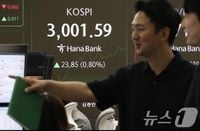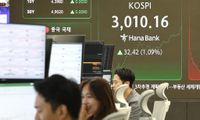South Korea's benchmark stock index, the KOSPI, surged past the 3,000-point mark during intraday trading on June 20, 2025, signaling a notable milestone not seen since early 2022. This breakthrough marks the first time in over three years and five months that the index has climbed above this critical level, rekindling optimism about the nation's stock market prospects and the broader economy.
According to the Korea Exchange, the KOSPI first breached the 3,000 threshold on January 6, 2021, reaching an all-time high of 3,316.08 points on June 25, 2021. However, a series of global and domestic challenges, including the COVID-19 pandemic, geopolitical tensions, and economic uncertainties, had since pushed the index below this level. The last intraday crossing above 3,000 had been recorded on January 3, 2022, at 3,010.77 points.
On the morning of June 20, 2025, the KOSPI opened at 2,986.52 points, an increase of 8.78 points (0.29%) from the previous trading day. By approximately 10:45 AM, the index had surpassed the 3,000 mark, reaching 3,000.46 points, up 22.72 points (0.76%). The upward momentum continued, with the KOSPI climbing to an intraday high of 3,004.37 points and hovering around 3,003.95 points by 11:10 AM.
Leading the charge were heavyweight stocks such as SK Hynix, LG Energy Solution, and HD Hyundai Heavy Industries, each posting gains exceeding 2%. SK Hynix, in particular, saw its shares rise over 3% intraday, trading at 254,500 won by mid-morning, up 3.46% from the previous day. Samsung Electronics also contributed to the rally, with its stock price edging up by approximately 0.34%, trading in the high 59,000 won range.
The rally was further supported by a broad-based advance in the market. Out of the KOSPI-listed stocks, 460 were on the rise, while 415 declined and 63 remained flat. The KOSDAQ index, South Korea's tech-heavy secondary market, also experienced gains, trading around 788.45 points by late morning, up roughly 0.76% from the previous session. Notably, companies like Raycom Robotics and Samcheon-dang Pharm posted significant intraday gains, with increases of 7.14% and 4.71%, respectively.
This resurgence in the KOSPI's fortunes is attributed to several factors. Foreign investors, who had been net sellers for much of the past nine months, shifted to net buying in June, signaling renewed confidence in the Korean market. Institutions also joined the buying spree, while individual investors, who had been key drivers of the market earlier, turned to selling amid the index's ascent above 3,000 points. Specifically, foreigners were net buyers of approximately 3.4 billion won, institutions purchased around 3.9 billion won worth of shares, and individuals sold about 7.6 billion won.
Market analysts note that the KOSPI's strong performance this year has been remarkable, with returns exceeding 24%, making it one of the best-performing global stock markets in 2025. The index's recent 14.88% gain over just 17 trading days—from 2,592.09 points on May 23 to 2,977.74 points on June 19—reflects a robust recovery and investor enthusiasm.
The backdrop to this rally includes easing U.S.-China trade tensions, expectations of a rate-cut cycle by the U.S. Federal Reserve in the latter half of 2025, and proactive economic stimulus policies by the South Korean government. The administration, led by President Lee Jae-myung, has emphasized reforms aimed at enhancing market transparency and investor protections, including revisions to corporate law and tax codes designed to reduce the so-called "Korea discount"—a term describing the undervaluation of Korean stocks relative to their global peers.
President Lee, shortly after his election, visited the Korea Exchange and underscored his commitment to transforming stock investment into an alternative to real estate, stating, "We will make stock investment a substitute investment instrument comparable to real estate." This vision has resonated with investors who are seeking diversified avenues for wealth accumulation amid shifting economic conditions.
However, challenges remain. Geopolitical risks, such as the ongoing tensions in the Middle East and the lingering effects of Russia's invasion of Ukraine, continue to cast shadows over global markets. Additionally, concerns about potential slowdowns in global economic growth and a downturn in South Korea's export sector pose risks to sustained market gains.
Despite these headwinds, some experts believe the current momentum may lead to an "overshooting" phenomenon driven by foreign investors, akin to the exuberance seen in 2021 when individual investors propelled the market. Lee Soo-jung, a researcher at Meritz Securities, remarked, "Unlike in 2021 when individuals led the surge, this time foreign buying may cause the domestic market to overshoot. We don't expect a waiting correction to occur."
Reflecting on the KOSPI's historical journey offers perspective on the significance of this milestone. Since its inception in January 1983, the index has weathered numerous economic cycles and crises. The 3,000-point level represents more than a numeric threshold; it symbolizes resilience and the potential for South Korea's capital markets to evolve amid global uncertainties.
As the trading day progressed on June 20, the KOSPI's ascent beyond 3,000 points rekindled hopes for a sustained bull market, driven by a combination of domestic reforms, improving foreign investor sentiment, and favorable macroeconomic factors. While caution is warranted given the complex geopolitical landscape, the renewed vigor in South Korea's stock market heralds a promising chapter for investors and the broader economy alike.





